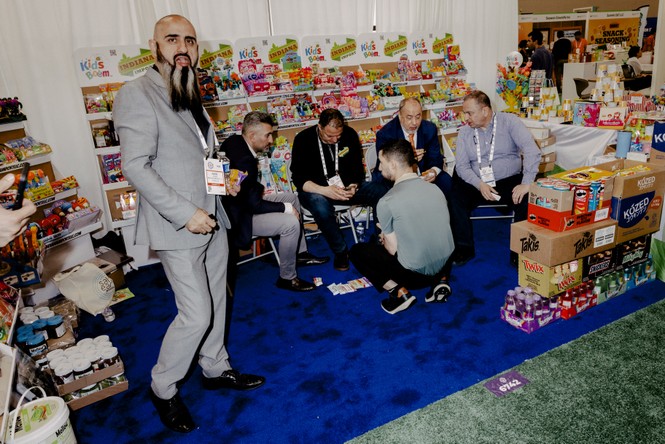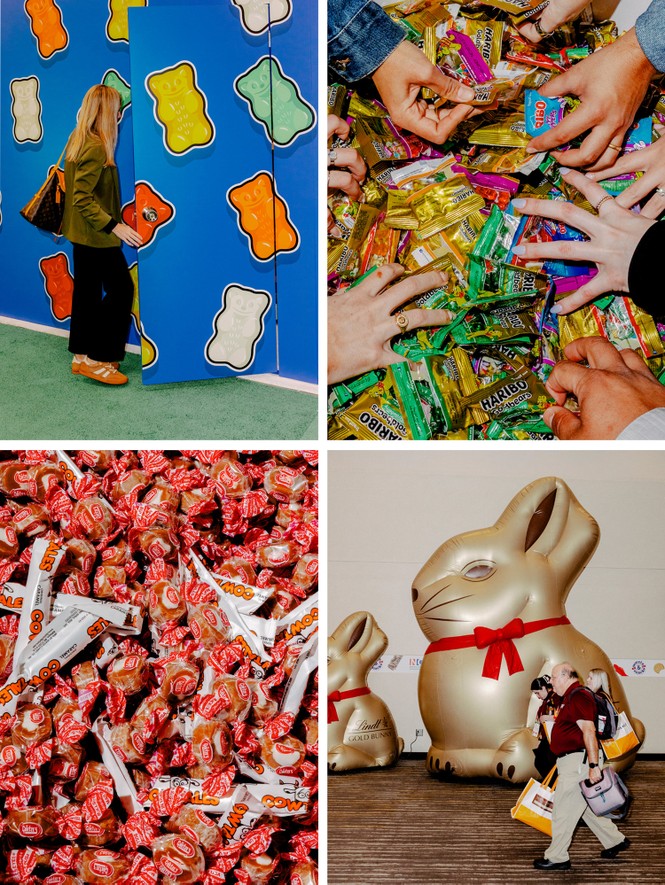Photographs by Evan Jenkins
A Wednesday morning in May is a strange time to be trick-or-treating—especially if you’re an adult wearing business casual. The Indiana Convention Center had just opened to visitors for the second day of Sweets & Snacks, the largest gathering of the candy and snack industry in North America. Along with nearly 15,000 other attendees, I went from booth to booth trying samples. By 10:40, I was sipping a complimentary blue-raspberry-watermelon Icee while a woman to my right took a selfie with Mr. Jelly Belly. At the Slim Jim booth a few feet away, a bunch of people in blazers gathered around a smorgasbord of meat sticks. The only thing that could get between attendees and their snacks was the occasional free beer or run-in with a mascot. At one point, the Jack Link’s sasquatch attempted to steal my Entenmann’s mini muffins.
I had come to Sweets & Snacks to taste the future of junk food. The annual conference is the industry’s most prominent venue to show off its new products. Judging by my three days in Indianapolis, the hot new trends are freeze-dried candy and anything that tastes vaguely East Asian: think “matcha latte” popcorn. But right now, that future looks shaky, particularly for confections. Candy embodies everything that Health and Human Services Secretary Robert F. Kennedy Jr. believes is wrong with the American diet. It’s mainly sugar (which Kennedy has called “poison”), counts as an ultra-processed food (which Kennedy has called “poison”), and is often colored with synthetic food dyes (which Kennedy has called “poison”). Last month, RFK Jr. announced a goal of eliminating synthetic food dyes by the end of 2026, a major threat to an industry predicated on making bright, eye-catching treats. In an email, an HHS spokesperson said that “Secretary Kennedy has been clear: we must build a healthier future by making smarter choices about what goes into our food.” The spokesperson added that “the secretary is committed to working with industry to prioritize public health.”

Evan Jenkins for The Atlantic
At Sweets & Snacks, I did not encounter an industry that was gearing up for change. Instead, it was RFK Jr.’s worst nightmare: an unabashed celebration of all things sugary, artificial, and indulgent. On the convention floor, it was hard to find a single product—beyond the litany of meat sticks and the occasional mixed nut—that would get RFK Jr.’s stamp of approval. Even a finalist for the convention’s annual salty-snack award, Vlasic Pickle Balls, contained tartrazine, a synthetic yellow dye that Kennedy has specifically bashed. As I stuffed my face with sugary treats, I began to wonder: Was the industry delusional about Kennedy, or the other way around?
RFK Jr.’s presence was conspicuously absent from the moment I arrived in Candy Land. “Anywhere over here is fine,” I told my Lyft driver as we pulled up to a hulking red M&M. Candy companies have already been investing in healthier options: Mars bought snack-bar maker Kind in 2020 and proudly displayed the bars in a booth alongside their more traditional M&Ms, Skittles, and Starburst. But the only vague mention of the looming RFK Jr. threat on the convention floor was a billboard posted by the conference’s organizers, the National Confectioners Association (NCA). It reiterated the candy lobby’s longstanding message: Candy shouldn’t be lumped together with other ultra-processed foods, because it is an occasional indulgence.
It’s hardly surprising that candy companies aren’t abruptly changing their products in response to pressure, even when it’s coming from the country’s top health regulator. Americans bought $54 billion worth of these treats last year. In April, the health secretary boasted that the U.S. food industry had “voluntarily agreed” to remove synthetic dyes from their products, but judging from the items on display at Sweets & Snacks, the candy industry has little interest in fulfilling that promise anytime soon. When I asked Christopher Gindlesperger, NCA’s senior vice president of public affairs and communication, if the candy industry had an understanding with RFK Jr. to eliminate synthetic dyes voluntarily, his response was simple: “No.”
Some of the discussions around dyes are understandably frustrating for the industry. Federal regulators haven’t done the sort of thorough academic evaluation of these dyes that’s typically expected before trying to push them out of the food supply. (The state of California released its own evaluation in 2021 and found that “synthetic food dyes are associated with adverse neurobehavioral outcomes in some children.”) At the same time, the candy industry isn’t doing much to signal that it recognizes the growing concern over these ingredients. It’s hard to be sympathetic toward companies that purposefully market unhealthy products to children through the use of mascots and funky colors. I was taken aback when I stumbled upon a Despicable Me–branded coloring set that let kids color in a cookie with a marker filled with tartrazine.

The industry’s efforts to uphold the status quo is risky. If Kennedy is intent on enforcing an actual ban on synthetic food coloring, it could have a monumental impact. Making the switch to natural colors is not as simple as FDA Commissioner Marty Makary let on when he told food makers during a press conference last month to just start coloring their products with fruit and vegetable juices. Natural colors are typically more expensive, and they’re far more finicky than their synthetic alternatives. Moisture, pH, and even light can cause the dyes to degrade. A naturally colored M&M might be red when it leaves the factory, but if it sits in your pantry too long, it could take on a not-so-appetizing color. There’s a question, too, of whether there are even enough fruits and vegetables in the world to supply the food industry with enough natural dye to serve the massive U.S. market. “The amount of crops that go into some of these dyes is just so high that we don’t necessarily have these crops planted,” Renee Leber, a food scientist at the Institute of Food Technologists, told me.
Here’s yet another concern: Natural dyes may alter the taste of certain treats. The company behind Dum-Dums lollipops has suggested that replacing artificial red dye with beet juice could make its red lollipops taste like beets. (That doesn’t mean it can’t be done. Many companies already sell products in Europe without synthetic dyes. And Katjes, a German company sandwiched between Jack Link’s and Harvest Snaps, was giving away its rainbow unicorn gummies, which looked plenty eye-catching to me, despite being colored solely with fruit and vegetable juices.)
Food dyes are only one part of the RFK Jr. threat that the candy industry faces right now. Yesterday, the Trump administration’s “MAHA Commission” released a much-touted report on childhood health, calling out sugar and ultra-processed foods as a major contributor to the youth chronic-disease problem. When I spoke with Gindlesperger, he was quick to point out that candy is far from the biggest cause of America’s sugar problem. (Sweetened drinks are.) “People understand that chocolate and candy are treats, and consumers have carved out a special place for them in their lives,” he said. He cited an analysis of CDC survey data that received funding from the NCA, which showed that people in the United States eat roughly 40 calories a day of candy.
But that analysis doesn’t distinguish between kids and adults. Data are scant on children’s consumption of candy, though if you’ve walked with a kid down a candy aisle, you can probably tell that most haven’t fully grasped that gummy worms are meant to be an occasional indulgence. “It’s really difficult for a child who has access to candy to stop eating it,” Natalie Muth, a pediatrician and dietitian, told me. Candy consumption among kids, she added, is a “big problem.”
In a country where nearly 20 percent of children are obese, more needs to be done to protect people from the candy industry’s worst tendencies. But mandating any such changes will be incredibly difficult for RFK Jr. To ban tartrazine alone, the FDA would need to compile a docket of information demonstrating its harm, issue a draft regulation, take public comments, and then finalize the regulation. Gindlesperger said the candy industry is waiting for the FDA to formally review the safety of the dyes it takes issue with: “We support and would welcome that review.” Even after all those steps, the food industry can—and likely would—sue. There’s even less precedent for cracking down on sugar. Kennedy has acknowledged that a sugar ban is unlikely, and instead has argued for more education about the risks of having a sweet tooth.
If Kennedy succeeds in ushering in actual reform, the “Make America Healthy Again” movement won’t truly revolutionize the American diet until it figures out how to redefine our relationship with certain foods. Whether Kennedy likes it or not, candy is part of our national psyche. He can’t simply wave a wand and ban trick-or-treating or candy canes. Over the course of three days, I saw grown adults fill multiple shopping bags with free treats. Candy companies displayed bags of their products to show retailers what they’d look like in a store, and the bags literally had to be taped down to avoid getting swiped. (Some still were.) I learned that attendees commonly bring a second suitcase just to haul their loot home.

Nothing quite epitomized the affection for treats like the impromptu dance party that broke out near the close of the conference. Chester Cheetah, Ernie the Keebler Elf, the purple Nerd, the Lemonhead, Bazooka Joe, Clark Cheese Head, and Chewbie, the Hi-Chew mascot, all began to sway in unison to a marching band that was hired to entertain guests. Conference attendees clamored to get a video of the spectacle and snap a selfie with their favorite mascot. The moment was absurd, and funny, and more than a little embarrassing. Still, I couldn’t help but pull out my own phone and crack a smile. Perhaps it was nostalgia for bygone Halloween nights, or maybe all the sugar was just getting to my head.
The post RFK Jr.’s Worst Nightmare appeared first on The Atlantic.




